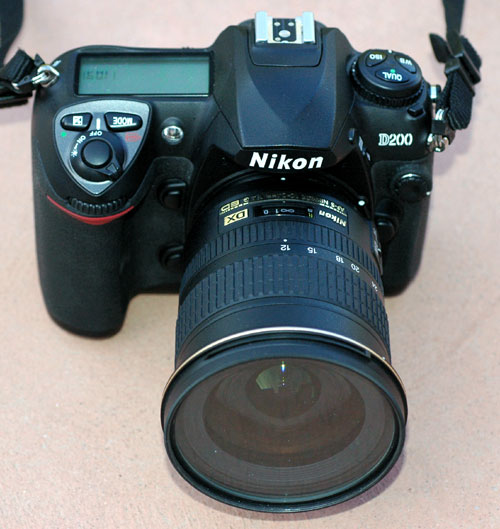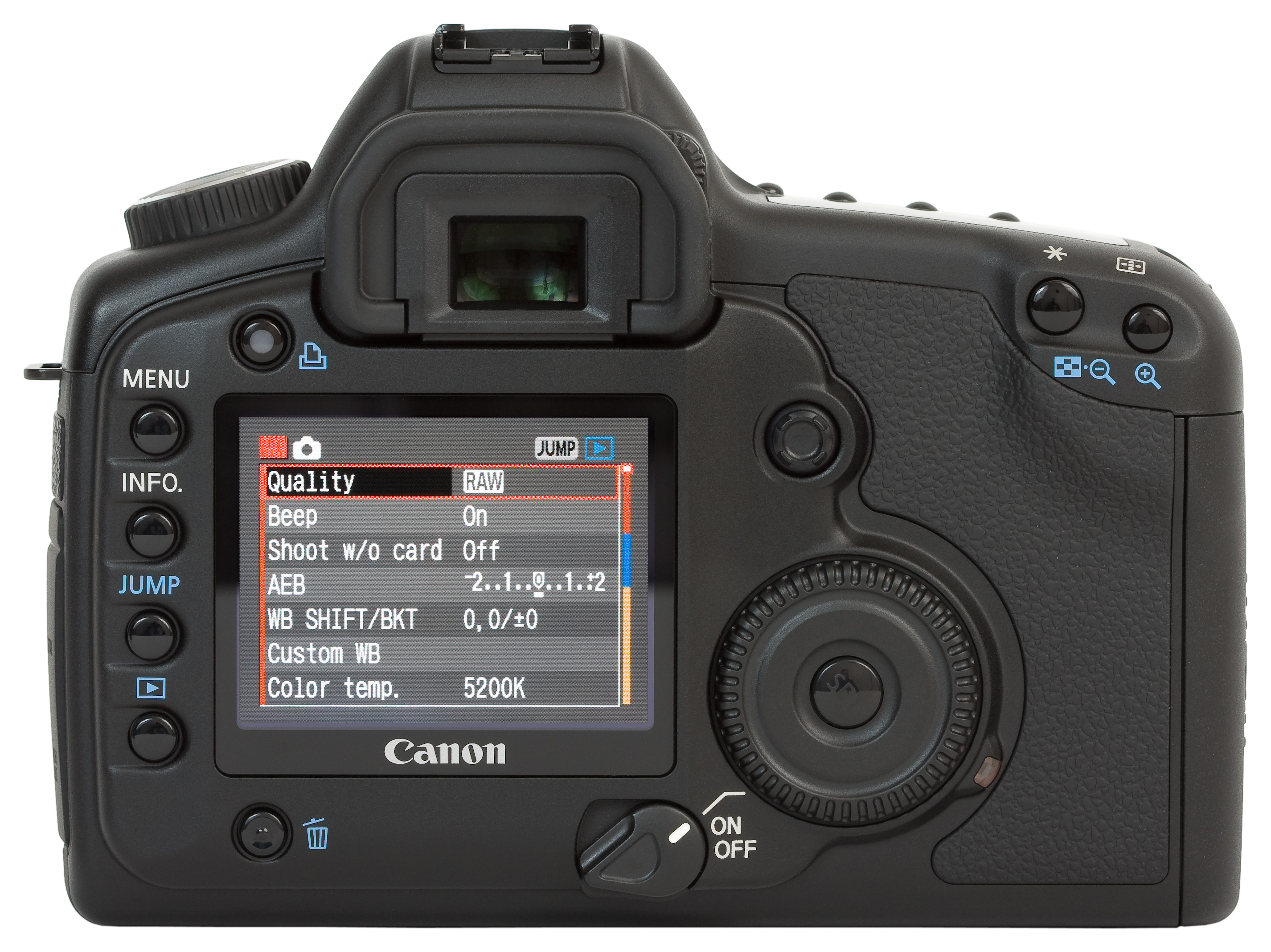|
Nikon D200
The Nikon D200 is a 10.2-megapixel digital single-lens reflex camera that falls between entry-level/midrange DSLR cameras such as the Nikon D40, Nikon D40x, and Nikon D80, D80 and high-end models such as the Nikon D2Hs and Nikon D2Xs, D2Xs. It was released by the Nikon Corporation in November 2005. The D200 was succeeded by the Nikon D300, D300 in August 2007. Comparison with other Nikon models Main advantages over the D40, D40x, D50, D60 and D80 cameras include: * More robust, metal (magnesium alloy) body incorporating environmental seals * Better matrix metering than D40, D50, or D80 (more sensor areas and less prone to overexposure) * Higher image resolution than D50 and D40, 10 MP instead of 6 MP (Note that the D40x and D60 are 10.2 MP) * 11-point autofocus system instead of a 3-point system (D40, D40x and D60) * Advanced Autofocus, continuous autofocus tracking options * More straightforward controls; many controls to adjust shooting settings (image quality, ISO, etc.) are d ... [...More Info...] [...Related Items...] OR: [Wikipedia] [Google] [Baidu] |
Nikon
(, ; ), also known just as Nikon, is a Japanese multinational corporation headquartered in Tokyo, Japan, specializing in optics and imaging products. The companies held by Nikon form the Nikon Group. Nikon's products include cameras, camera lenses, binoculars, microscopes, ophthalmic lenses, measurement instruments, rifle scopes, spotting scopes, and the steppers used in the photolithography steps of semiconductor fabrication, of which it is the world's second largest manufacturer. The company is the eighth-largest chip equipment maker as reported in 2017. Also, it has diversified into new areas like 3D printing and regenerative medicine to compensate for the shrinking digital camera market. Among Nikon's many notable product lines are Nikkor imaging lenses (for F-mount cameras, large format photography, photographic enlargers, and other applications), the Nikon F-series of 35 mm film SLR cameras, the Nikon D-series of digital SLR cameras, the Nikon Z-series of digital mi ... [...More Info...] [...Related Items...] OR: [Wikipedia] [Google] [Baidu] |
Autofocus
An autofocus (or AF) optical system uses a sensor, a control system and a motor to focus on an automatically or manually selected point or area. An electronic rangefinder has a display instead of the motor; the adjustment of the optical system has to be done manually until indication. Autofocus methods are distinguished as active, passive or hybrid types. Autofocus systems rely on one or more sensors to determine correct focus. Some AF systems rely on a single sensor, while others use an array of sensors. Most modern SLR cameras use through-the-lens optical sensors, with a separate sensor array providing light metering, although the latter can be programmed to prioritize its metering to the same area as one or more of the AF sensors. Through-the-lens optical autofocusing is usually speedier and more precise than manual focus with an ordinary viewfinder, although more precise manual focus can be achieved with special accessories such as focusing magnifiers. Autofocus accuracy ... [...More Info...] [...Related Items...] OR: [Wikipedia] [Google] [Baidu] |
Speedlight
Speedlight is the brand name used by Nikon Corporation for their photographic flash units, used since the company's introduction of strobe flashes in the 1960s. Nikon's standalone Speedlights (those not built into the company's cameras) have the ''SB-'' prefix as part of their model designation. Current Speedlights and other Nikon accessories make up part of Nikon's ''Creative Lighting System'' (CLS), which includes the ''Advanced Wireless Lighting'', that enables various Nikon cameras to control multiple Nikon flash units in up to three separate controlled groups by sending encoded pre-flash signals to slave units. Nikon's competitors like Canon and Ricoh use the similar name Speedlite for their flashes. Both names indicate that strobe flashes produce much shorter and more intense bursts of light than earlier photographic lighting systems, such as flashbulbs, or continuous lamps used in some studio situations. Models Nikon's Speedlight units are: (Update September 15, 2014) * SB ... [...More Info...] [...Related Items...] OR: [Wikipedia] [Google] [Baidu] |
Film Speed
Film speed is the measure of a photographic film's sensitivity to light, determined by sensitometry and measured on various numerical scales, the most recent being the ISO system. A closely related ISO system is used to describe the relationship between exposure and output image lightness in digital cameras. Relatively insensitive film, with a correspondingly lower speed index, requires more exposure to light to produce the same image density as a more sensitive film, and is thus commonly termed a ''slow film''. Highly sensitive films are correspondingly termed ''fast films''. In both digital and film photography, the reduction of exposure corresponding to use of higher sensitivities generally leads to reduced image quality (via coarser film grain or higher image noise of other types). In short, the higher the sensitivity, the grainier the image will be. Ultimately sensitivity is limited by the quantum efficiency of the film or sensor. Film speed measurement systems His ... [...More Info...] [...Related Items...] OR: [Wikipedia] [Google] [Baidu] |
Angle Of View
The angle of view is the decisive variable for the visual perception of the size or projection of the size of an object. Angle of view and perception of size The perceived size of an object depends on the size of the image projected onto the retina. The size of the image depends on the angle of vision. A near and a far object can appear the same size if their edges produce the same angle of vision. With an optical device such as glasses or binoculars, microscope and telescope the angle of vision can be widened so that the object appears larger, which is favourable for the resolving power of the eye (see visual angle). Angle of view in photography In photography, angle of view (AOV) describes the angular extent of a given scene that is imaged by a camera. It is used interchangeably with the more general term field of view. It is important to distinguish the angle of view from the angle of coverage, which describes the angle range that a lens can image. Typically the image ... [...More Info...] [...Related Items...] OR: [Wikipedia] [Google] [Baidu] |
12-24-Nikkor
1 (one, unit, unity) is a number A number is a mathematical object used to count, measure, and label. The original examples are the natural numbers 1, 2, 3, 4, and so forth. Numbers can be represented in language with number words. More universally, individual numbers c ... representing a single or the only entity. 1 is also a numerical digit and represents a single unit (measurement), unit of counting or measurement. For example, a line segment of ''unit length'' is a line segment of length 1. In conventions of sign where zero is considered neither positive nor negative, 1 is the first and smallest Positive number, positive integer. It is also sometimes considered the first of the sequence (mathematics), infinite sequence of natural numbers, followed by 2, although by other definitions 1 is the second natural number, following 0. The fundamental mathematical property of 1 is to be a multiplicative identity, meaning that any number multiplied by 1 equa ... [...More Info...] [...Related Items...] OR: [Wikipedia] [Google] [Baidu] |
NCIS (TV Series)
''NCIS'' is an American police procedural television series, revolving around a fictional team of special agents from the Naval Criminal Investigative Service combining elements of the military drama and police procedural genres. The concept and characters were initially introduced in two episodes of the CBS series '' JAG'' ( season eight episodes 20 and 21: " Ice Queen" and "Meltdown"). A spin-off from ''JAG'', the series premiered on September 23, 2003, on CBS. To date it has entered into the twentieth full season and has gone into broadcast syndication on the USA Network. Donald P. Bellisario and Don McGill are co-creators and executive producers of the premiere member of the ''NCIS'' franchise. , ''NCIS'' is the third-longest-running scripted, non-animated U.S. primetime TV series currently airing, surpassed only by '' Law & Order: Special Victims Unit'' (1999–present) and ''Law & Order'' (1990–2010; 2022–present); it is the 7th-longest-running scripted U.S. prime ... [...More Info...] [...Related Items...] OR: [Wikipedia] [Google] [Baidu] |
Super CCD
Super CCD is a proprietary charge-coupled device that has been developed by Fujifilm since 1999. The Super CCD uses octagonal, rather than rectangular, pixels. This allows a higher horizontal and vertical resolution (at the expense of diagonal resolution) to be achieved than a traditional sensor of an equivalent pixel count. On January 21, 2003 Fujifilm announced the fourth generation of SuperCCD sensors, in two variations: SuperCCD HR and SuperCCD SR. HR stands for "high resolution" and SR stands for "super dynamic range". The SR sensor has two photodiodes per photosite, one much larger than the other. Appropriately processing information from both can yield larger black to white range of brightness (dynamic range). The 4th Generation Super CCD HR has sensors placed at 45 degrees to the horizontal. In order to convert the images into the normal horizontal/vertical pixel orientation, it interpolates one pixel between each pair of sensors, thereby producing 12 recorded megapixel ... [...More Info...] [...Related Items...] OR: [Wikipedia] [Google] [Baidu] |
FinePix S5 Pro
The FinePix S5 Pro is a digital single lens reflex camera introduced by Fujifilm on 25 September 2006 and since discontinued. It replaces the previous FinePix S3 Pro and keeps the Nikon F mount compatibility, including DX size lenses. It is based on the Nikon D200 body, and benefits from its improvements: 11-point autofocus, i-TTL flash, a bigger LCD and a lithium-ion battery. It has a Super CCD 23×15.5 mm image sensor of the same configuration as its predecessor, with 6.17 million low sensitivity pixels and 6.17 million high sensitivity pixels to give a high dynamic range, and a boost to 3200 ISO. It introduces also a face detection feature for reviewing those details faster and an improved iteration of the S3 Pro's "live view" function to help focusing, and to take pictures without using the viewfinder. It is possible to use it in tethered operation, to connect a barcode reader and a wired ethernet or Wi-Fi link. Compatibility with Nikon D200 battery systems While the ... [...More Info...] [...Related Items...] OR: [Wikipedia] [Google] [Baidu] |
Canon EOS 5D
The Canon EOS 5D is a 12.8 megapixel digital single-lens reflex (DSLR) camera body produced by Canon. The EOS 5D was announced by Canon on 22 August 2005, and at the time was priced above the EOS 20D but below the EOS-1D Mark II and EOS-1Ds Mark II in Canon's EOS digital SLR series. The camera accepts EF lens mount lenses. The EOS 5D is notable for being the first full-frame DSLR camera with a standard body size (as opposed to the taller, double-grip "professional" camera body style). It is also notable for its price, suggested at US$3299 without lens, which set a significant new low price point for full-frame DSLRs; its only full-frame competition at the time was the Canon 1Ds Mark II, which cost more than twice as much. On 17 September 2008, Canon announced the camera's successor, the Canon EOS 5D Mark II. Features Sensor and image processing The 5D has a DIGIC II processor and a 35.8 x 23.9 mm full-frame CMOS sensor with 13.3 million pixels (12.7 megapixel effecti ... [...More Info...] [...Related Items...] OR: [Wikipedia] [Google] [Baidu] |
Canon EOS 30D
The Canon EOS 30D is an 8.2-megapixel semi-professional digital single-lens reflex camera, initially announced on February 21, 2006. It is the successor of the Canon EOS 20D, and is succeeded by the EOS 40D. It can accept EF and EF-S lenses, and like its predecessor, it uses an APS-C sized image sensor, so it does not require the larger imaging circle necessary for 35 mm film and 'full-frame' digital cameras. Improvements Changes over the 20D include a bigger LCD rear screen, improved shutter mechanism rated for 100,000 actuations, improved frame capacity, 1/3 stop increments for sensor speed and an added spot meter. This unit retains the same sensor as its predecessor; all lenses still have an angle of view crop of 1.6. Other changes include a larger 11 frame RAW / 30 frame JPEG buffer, and slightly faster 0.15 second startup. The maximum frame rate is the same (5 frame/s), but a lower-speed 3 frame/s option has been added. The 30D uses the same number of autofocus point ... [...More Info...] [...Related Items...] OR: [Wikipedia] [Google] [Baidu] |







